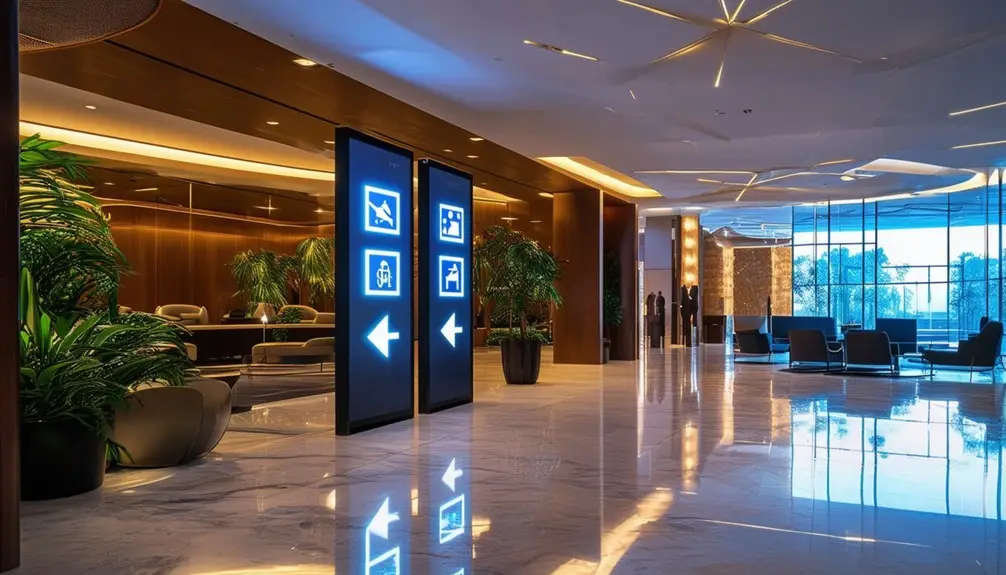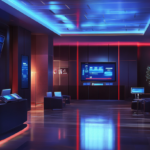Digital directional signs elevate your hotel’s guest experience by offering real-time navigation and interactive maps that reduce confusion. Utilize self-service touchscreen kiosks for intuitive wayfinding and provide customized content tailored to guest needs. These signs display property layouts, event schedules, and local attractions, enhancing satisfaction. Integrated room signs can show event schedules and allow personalized faceplates. Cloud-based systems permit easy content updates, ensuring accurate, timely information. Enhance brand loyalty with dynamic media slideshows and automated content delivery. Discover more about maximizing guest satisfaction and operational efficiency through digital signage solutions.
Key Takeaways
- Interactive wayfinding maps provide intuitive self-service navigation, reducing guest confusion.
- Digital room signs offer real-time updates on room status, minimizing booking errors.
- Self-service touchscreen kiosks display property layouts and event schedules for enhanced guest satisfaction.
- Cloud-based remote screen management ensures timely updates and accurate information delivery.
- Customizable content and voice user interfaces enhance the overall guest experience.
Maximizing Guest Experience
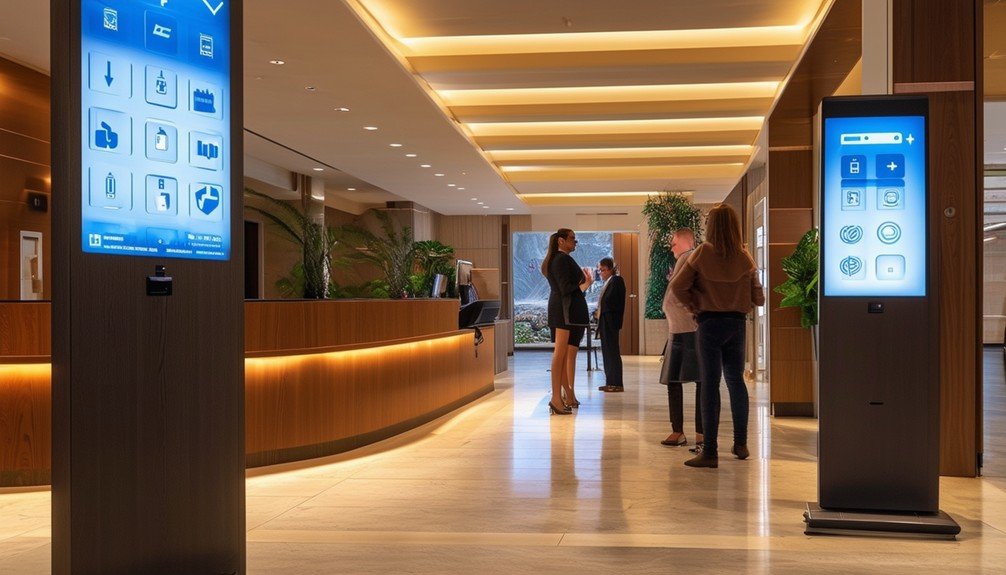
Maximizing guest experience begins with digital directional signs that provide interactive maps for effortless navigation throughout the hotel. Digital Signage for Hotels guarantees that guests can easily find their way around the property, reducing confusion and enhancing overall satisfaction. By displaying clear, interactive wayfinding maps, these signs can show property layouts, event schedules, and even local attractions, making it simpler for guests to plan their activities.
For instance, room signs placed outside meeting rooms and event spaces can be integrated with event schedules from apps like Delphi by Amadeus Hospitality. This integration allows guests to quickly locate specific rooms and stay informed about ongoing events. The dynamic nature of these signs means that they can be updated in real-time, ensuring that guests always have the most current information.
Customizing digital room sign faceplates to match the venue’s décor adds a personalized touch, blending functionality with aesthetics. This attention to detail not only helps in wayfinding but also enhances the hotel’s overall ambiance. By leveraging digital signage, hotels can provide a seamless, interactive experience that prioritizes guest convenience and satisfaction.
Self-Service Solutions
Self-service touchscreen maps and interactive kiosks can transform your hotel’s navigation experience. These solutions display detailed property maps, restroom locations, and elevator positions while providing point-to-point directions. By integrating tailored content and voice user interfaces, you offer guests a seamless, hands-free option for accessing essential information.
Self-Service Touchscreen Maps
Interactive touchscreen maps in hotel lobbies provide guests with efficient, user-friendly navigation tools for locating rooms, restrooms, and event venues. By integrating interactive kiosks into your hotel, you can markedly enhance the guest experience. These kiosks feature wayfinding maps that give point-to-point directions, ensuring that guests can effortlessly find their way around the property.
Self-service touchscreen maps are a game-changer for hotels, offering a digital interface that displays property layouts, floor maps, and directories of rooms, events, and personnel. The touchscreens are intuitive, allowing guests to quickly access the information they need. Additionally, these kiosks can be customized with tailored content and even voice user interfaces for a hands-free experience.
| Feature | Benefit |
|---|---|
| Interactive Kiosk | Enhances guest experience |
| Wayfinding Maps | Clear, point-to-point directions |
| Customizable Content | Tailored to guest needs |
Implementing these digital directional signs streamlines wayfinding and elevates the overall guest experience. Guests no longer have to wander aimlessly or wait in long lines at the front desk for assistance. Instead, they can interact directly with the kiosk to get precise, up-to-date information, which notably improves their stay.
Interactive Kiosk Benefits
By leveraging the power of interactive stands, hotels can provide guests with seamless, self-service solutions that enhance their overall experience. These digital display solutions offer a range of functionalities through easy-to-use touchscreen interfaces. Guests can access detailed property and floor maps, locate restrooms and elevators, and find essential information with just a few taps.
Interactive stands serve as thorough digital directories, allowing guests to quickly look up rooms, events, personnel, or departments. This reduces the need for staff assistance and speeds up the process of finding critical information. The point-to-point directions provided by these stands make maneuvering large hotel properties straightforward and stress-free.
Customized interactive stands can display tailored content, adapting to the specific needs of each hotel. Features like voice user interfaces offer a hands-free option, making it even more convenient for guests to interact with the system. By integrating these advanced digital display solutions, hotels not only improve guest satisfaction but also streamline operations. Implementing interactive stands is a strategic move to enhance the guest experience while efficiently managing hotel resources.
Interactive Wayfinding
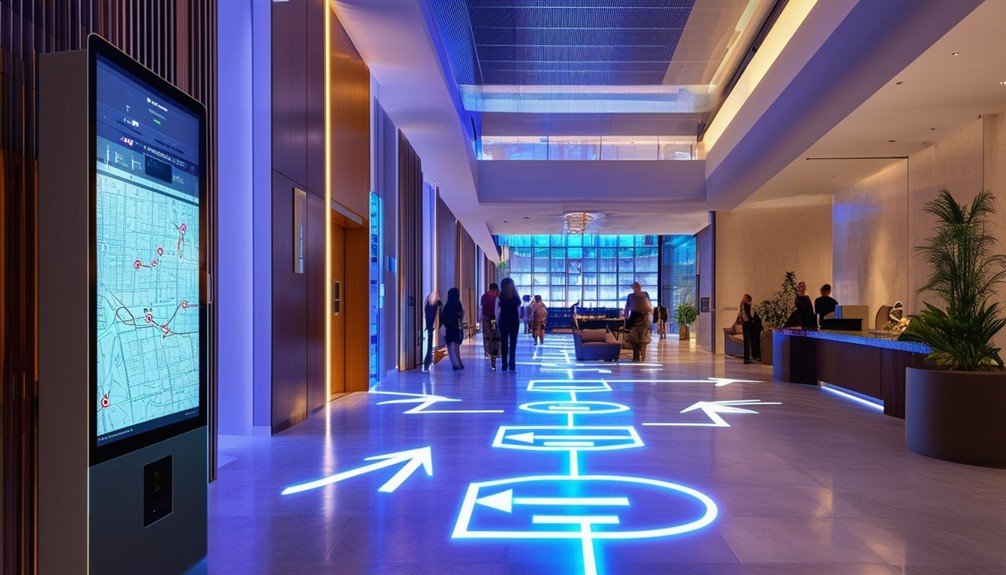
When you implement touchscreen navigation in your hotel, guests benefit from intuitive, self-service wayfinding. Real-time map updates guarantee that any changes to the property layout are instantly reflected, minimizing confusion. Additionally, customizable user interfaces allow you to tailor the experience to meet specific guest needs, enhancing overall satisfaction.
Touchscreen Navigation Benefits
Utilizing touchscreen navigation systems in hotels greatly reduces guest stress by providing self-service information for efficient venue navigation. With digital signage and wayfinding, guests can easily access interactive maps that display property layouts, restroom locations, elevator positions, and other key areas. These systems streamline the experience, guaranteeing guests find their way without hassle.
Interactive kiosks are equipped with directories of rooms, events, personnel, and departments, enhancing your overall stay. You can quickly locate specific areas or individuals without needing to ask for directions, making your visit more enjoyable and less time-consuming.
Self-service touchscreen maps provide point-to-point directions, offering a detailed and intuitive user experience. By simply tapping on the screen, you can get precise directions to your destination, notably improving navigation within the hotel. Additionally, these kiosks can be customized with tailored content and voice user interfaces, giving you a hands-free option that’s both modern and convenient.
Incorporating touchscreen navigation into hotels not only improves guest satisfaction but also promotes efficient and effective wayfinding. This innovative approach guarantees that you have all the information you need at your fingertips, making your stay as smooth and stress-free as possible.
Real-Time Map Updates
Interactive touchscreen systems not only enhance wayfinding but also incorporate real-time map updates, guaranteeing guests have the most current and precise information at their fingertips. These systems use sophisticated digital signage software to provide interactive maps that display crucial locations like restrooms, elevators, meeting rooms, and event spaces. By leveraging real-time data, these maps can adapt to changes instantly, offering guests seamless guidance experiences.
When you’re exploring a large hotel, the interactive maps on these digital directional signs can quickly direct you from point A to point B. Whether you’re searching for the nearest restroom or trying to locate an elevator, these maps update dynamically to reflect the most precise routes. The integration of real-time updates ensures that any layout changes or temporary closures are immediately reflected on the map, eliminating confusion and enhancing your experience.
The self-service touchscreen maps allow you to interact directly with the digital signage software, providing point-to-point directions and guaranteeing you reach your destination efficiently. These real-time map updates are crucial for maintaining the accuracy and reliability of interactive wayfinding, making sure you never get lost in a sprawling venue.
Customizable User Interfaces
Customizable user interfaces on digital directional signs offer guests a tailored experience, allowing them to interact with maps and directories in a way that suits their specific needs. These user interfaces, integrated into interactive wayfinding kiosks, provide a custom welcome and adapt to individual preferences. With self-service information readily available, guests can reduce stress and enjoy a more seamless experience.
Interactive wayfinding maps are designed to enhance user experience by offering personalized and detailed point-to-point directions. Here’s how these customizable user interfaces can benefit your guests:
- Tailored Content: Guests can view property maps, restroom locations, and elevator positions, ensuring they find what they need quickly.
- Voice User Interfaces: For a hands-free option, voice commands can be integrated, allowing guests to navigate without touching the screen.
- Custom Welcome Messages: Personalized greetings and recommendations can be displayed, making guests feel valued and well-informed.
Enhancing Brand Loyalty
Digital directional signs in hotels can significantly enhance brand loyalty by delivering timely information and promotions that resonate with guests. By integrating Hotel Digital solutions, you can greatly improve guest experiences and the overall visitor experience. These signs enable you to upsell services and unique offerings, boosting guest engagement and satisfaction.
Featuring local events, attractions, and on-site amenities on digital signs creates a personalized guest experience. Imagine a guest seeing an inviting display about a nearby festival or a special dinner in your hotel restaurant. Cloud-based control of digital signage guarantees you can easily update and customize content to meet guests’ needs and preferences. This flexibility allows you to swiftly adapt to changing circumstances or guest demographics.
Dynamic media slideshows and customizable zones on these signs capture guest attention and drive brand loyalty. For instance, you can highlight spa services, room upgrades, or exclusive deals, making guests feel valued and informed. The more you tailor the content to your guests’ interests, the stronger their connection to your brand will be. Ultimately, well-implemented digital directional signs not only guide guests but also enrich their overall experience, fostering long-term loyalty.
Room Signage
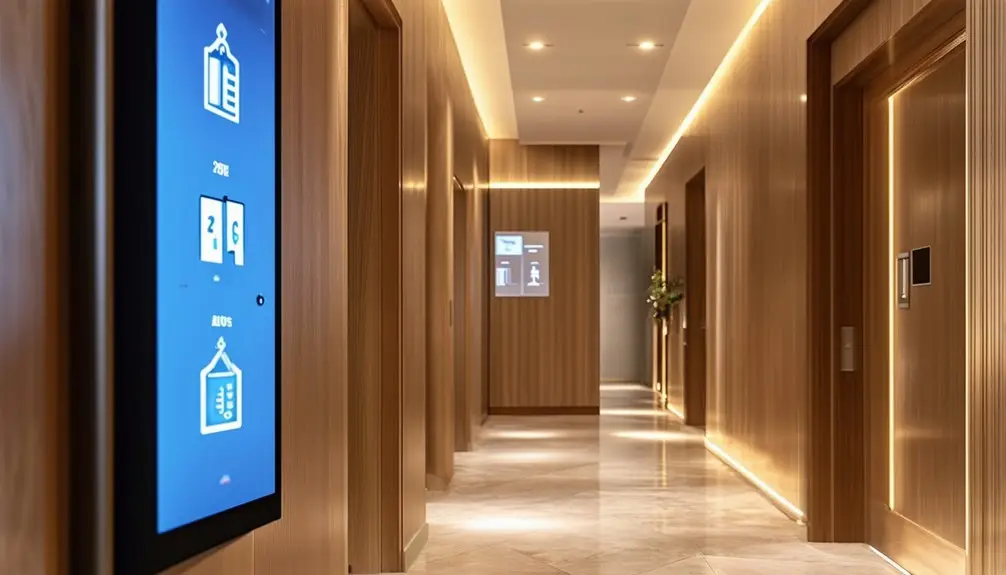
Room signage in hotels revolutionizes the way guests and staff manage conference room bookings and availability, guaranteeing a seamless and efficient process. By integrating Zoney digital signage, you can modernize your hotel’s booking system with interactive room signage that provides real-time updates on room status and availability.
With interactive room signage, guests can easily check room availability and book rooms using cloud-based software integrated with popular scheduling apps. Here’s what you can expect:
- User-Friendly Interface: Compact and sleek touch-screen devices make it simple for guests to navigate the booking system and reserve a room.
- Real-Time Updates: Cloud-based software guarantees that both guests and staff have up-to-the-minute information on room bookings and availability.
- Efficient Operations: Streamlining the room booking process for both guests and staff minimizes double-bookings and administrative errors.
Reader/Event Boards
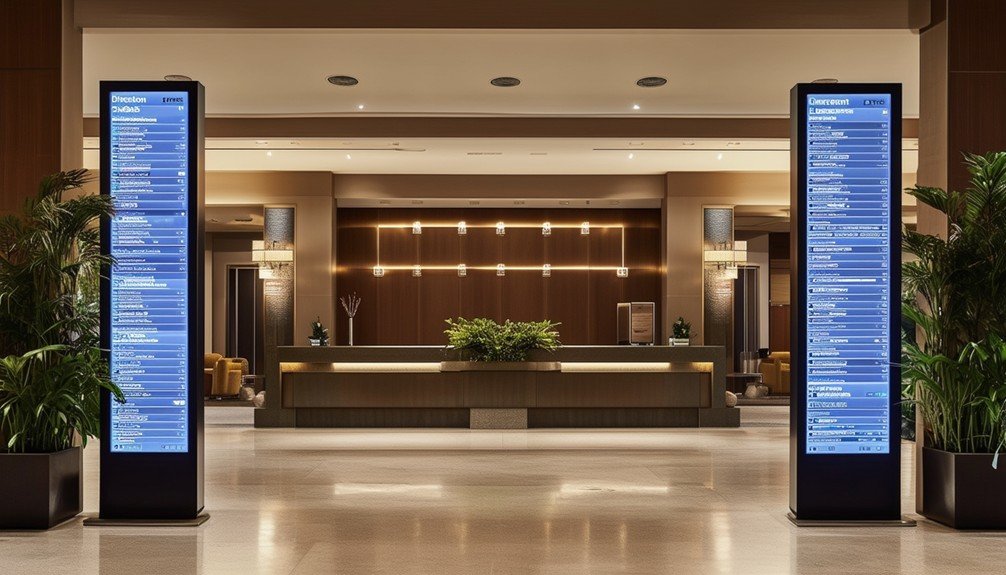
Reader/Event Boards in hotel lobbies offer guests and staff up-to-date information on events and meetings, ensuring everyone stays informed and organized. These digital signs are vital tools, seamlessly integrating with existing scheduling or reservation software to display real-time event schedules. By linking directly to these systems, the boards automatically update, eliminating the need for manual adjustments and reducing errors.
Interactive features on Reader/Event Boards greatly enhance the guest experience. Guests can easily access wayfinding assistance, helping them navigate to various event locations within the hotel. Additionally, these boards can offer information on local attractions, providing a detailed guide to both on-site and off-site activities.
The implementation of Reader/Event Boards streamlines communication with guests, ultimately enhancing overall guest satisfaction. The ease of accessing scheduled events and meetings at a glance ensures a smoother experience for everyone involved. Moreover, these boards can be managed through cloud-based software, allowing for swift updates and customization. This capability guarantees that any changes to event schedules or additional information can be promptly reflected on the screens, maintaining the accuracy and relevance of the displayed information.
Remote Screen Management
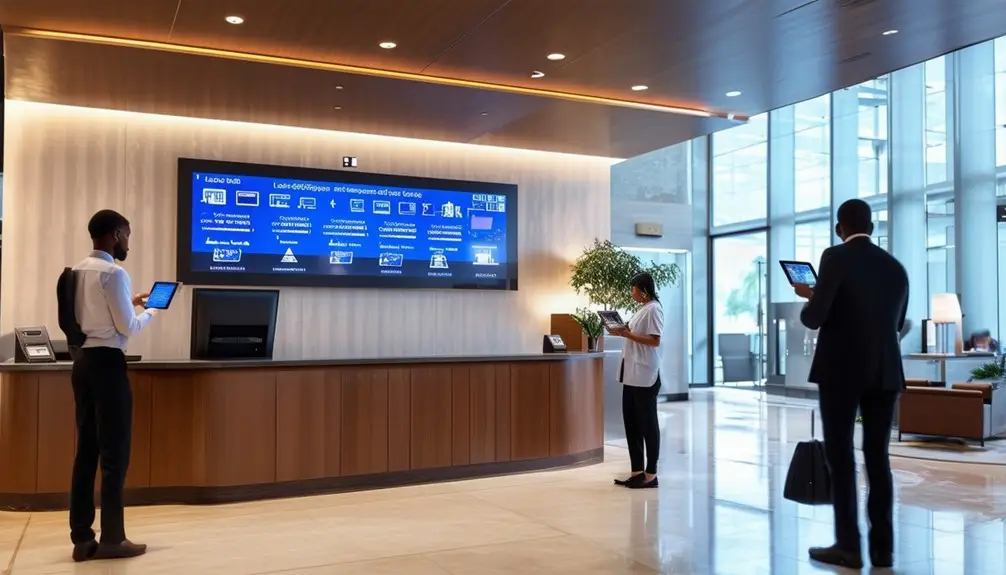
With remote screen management, you can effortlessly update and control digital directional signs in hotels from any PC or MAC. This capability is pivotal for maintaining up-to-date information across your property, ensuring guests always find what they need. By sending updates to one or multiple screens with just one click, you streamline the entire process, saving time and reducing errors.
Here are three key features of remote screen management:
- Prescheduled Playlists: Set playlists to display specific content at designated times or on recurring days to automate production at any time, ensuring your guests receive timely and relevant information.
- Monitoring and Reports Dashboard: Access a centralized dashboard to monitor screen status in real-time and generate proof-of-play reports, giving you insights into content delivery and screen performance.
- Essential Notifications: Quickly display event notifications, schedules, maps, and custom greetings to keep your guests informed and engaged.
Remote screen management not only enhances operational efficiency but also elevates the guest experience by ensuring that directional signs are always current and accurate. Embrace this technology to maintain seamless communication and improve the overall guest journey.
Comprehensive Control Options
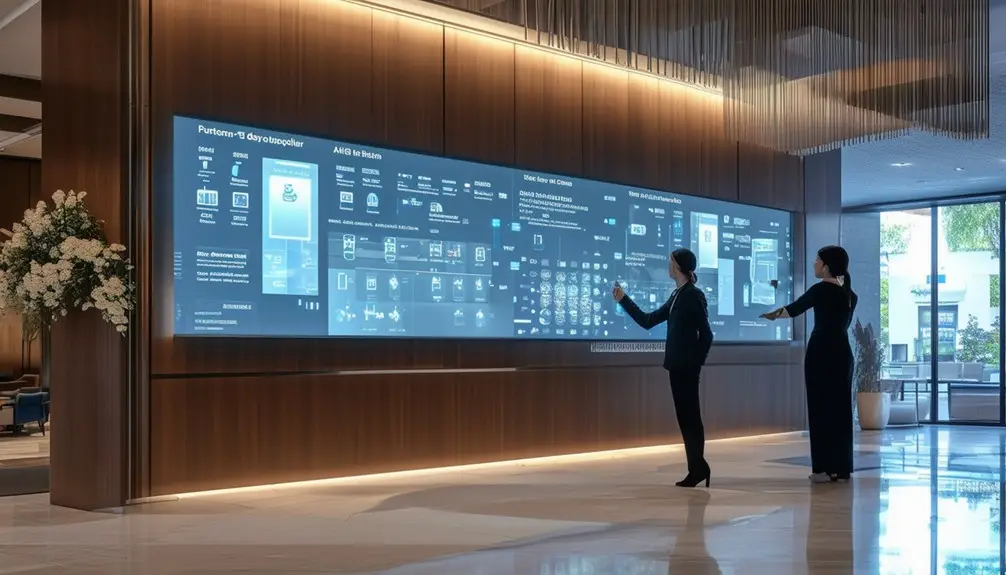
Extensive control options in digital directional signs empower hotel staff to create, update, and distribute content seamlessly across multiple devices, guaranteeing guests always have access to accurate and timely information. When you start using it RIGHT, you’ll quickly notice the efficiency and convenience it brings. You can remotely update and send information to screens with just a click, eliminating manual updates.
These signs add wayfinding capabilities, making it easier for guests to navigate the hotel. Advanced scheduling features allow you to display event notifications, schedules, maps, and custom greetings precisely when needed. This level of control assures that your guests are always in the know, enhancing their overall experience.
Digital directional signs are compatible with various devices like screens, tablets, and kiosks, offering unparalleled versatility. Here’s a quick comparison table to illustrate the advantages:
| Feature | Benefit | Device Compatibility |
|---|---|---|
| Remote Updates | Enhanced Efficiency | Screens, Tablets, Kiosks |
| Advanced Scheduling | Timely Event Notifications | Screens, Tablets, Kiosks |
| Content Creation | Custom Greetings and Maps | Screens, Tablets, Kiosks |
Switch to production mode with these signs and see how they transform guest navigation and communication within your hotel. This robust system assures that your information is always current and precisely tailored to your guests’ needs.
Conclusion
By embracing digital directional signs, you’re not only enhancing guest experience but also streamlining self-service solutions. Interactive wayfinding guarantees efficient navigation, while room signage and reader/event boards bolster brand loyalty. Remote screen management and extensive control options provide precise, powerful performance. This technology transforms traditional hospitality into a modern marvel, making your hotel a haven of high-tech hospitality.
Frequently Asked Questions
What Are the Four Types of Wayfinding Signage?
You’re asking about the four types of wayfinding signage. They include identification signs, which locate specific areas; directional signs, which guide navigation; informational signs, which detail amenities; and regulatory signs, which communicate rules.
What Is Dynamic Digital Signage?
Dynamic digital signage refers to screens displaying real-time, changing content like promotions and updates. You can control these remotely, making it easy to provide interactive, visually appealing information that enhances user experience and satisfaction.
What Device Is Used for Digital Signage?
You’ll use commercial-grade displays like LCD or LED screens for digital signage. These can be interactive touchscreens, video walls, or standalone kiosks. You’ll also need digital signage software for content management and scheduling.
What Is Interactive Digital Signage?
Interactive digital signage lets you engage with screens via touch, gestures, or voice commands. It provides real-time info, maps, event schedules, and personalized content, enhancing your experience by making navigation and accessing services easier.

